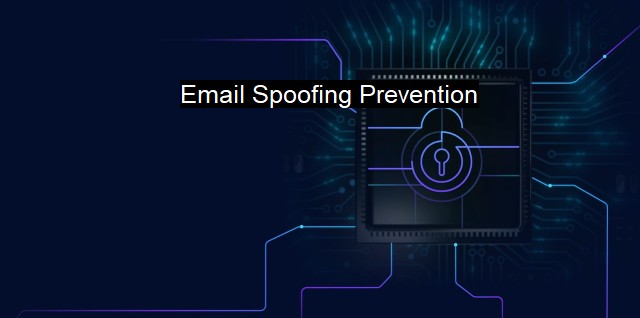What is Email Spoofing Prevention?
Preventing Breaches: Your First Line of Defense - Email Spoofing Prevention
Email spoofing prevention is an essential aspect of cybersecurity, focusing on protecting users from deceptive and potentially harmful emails, often associated with phishing attacks, created to imitate genuine emails. Email spoofing is a practice in which an email sender's name and address are altered to appear as though the email originates from a different source. These deceptive practices are utilized to induce individuals into revealing sensitive data or unknowingly downloading malicious software.Email spoofing is primarily employed in phishing scams and spam campaigns. Phishers reproduce emails from trusted organizations, such as financial institutions or own user accounts, prompting the recipient to divulge private information such as passwords, credit card numbers or social security numbers. In spam campaigns, spoofed emails are used to deliver unwanted information, or lure users into clicking links that lead to malware-infested sites, consequently spreading viruses and compromising the security of their computers.
Email spoofing prevention refers to measures and techniques incorporated to protect users from these deceptive and potentially dangerous emails. The aim is to secure and maintain the integrity of communication channels, safeguarding users' sensitive information, and ensuring a safer digital environment.
There are several ways businesses and individuals can help prevent email spoofing. The first is through the implementation of robust spam filters. These filters scrutinize incoming mail against known phishing tactics and spam campaigns, filter emails from unrecognized senders, and quarantine suspicious emails.
Sender Policy Framework (SPF) is another commonly used method for detecting and deterring spoofed emails. SPF is a simple email-validation system allowing mail exchangers to check if incoming mail from a particular domain comes from a host authorized by that domain's administrators, thus drastically reducing the number of fake emails that reach users' inboxes.
Domain-based Message Authentication, Reporting & Conformance (DMARC) and DomainKeys Identified Mail (DKIM) are two additional email validation systems designed to detect email spoofing. DMARC establishes a robust governing policy dictating how domain-based email authentication failures should be handled, while DKIM attaches a so-called DKIM signature to every email, which can be used to verify that it was sent by its supposed sender.
Despite advances in technologies and system protocols, email spoofing remains an ongoing problem due to human factors. Since scammers are particularly skilled at persuading their targets, many users inadvertently share their private information, download malicious files and click on potentially detrimental links.
This highlights the importance of expanding user awareness about the threat of email spoofing. Regular cybersecurity training is deemed necessary, as it illustrates to senders the telltale signs of spoofed emails. When users know how to discern between legitimate and fraudulent emails, they considerably reduce their vulnerability to various cyber threats.
Businesses often employ a proactive strategy towards phishing, engaging in so-called 'ethical phishing.' Here, specialist teams craft realistic 'phishing' emails and send these to their employees. If employees interact with these emails, it highlights the need for further training.
Email spoofing prevention is an integral part of the cybersecurity landscape, aiming to protect end-users from being tricked into sharing sensitive data or downloading malware. While robust spam filters, SPF, DKIM, DMARC represent methods to technically prevent email spoofing, education and awareness are equally important. As cybersecurity is a continually evolving field, maintaining a state of preparedness, being informed, and regular testing are all essential to keeping email communication channels secure.

Email Spoofing Prevention FAQs
What is email spoofing and why is it a cybersecurity concern?
Email spoofing is a form of cyberattack where an attacker disguises their email address to make it appear as if the email came from someone else. This can be dangerous because attackers can use this technique to trick individuals into giving away sensitive information or downloading malicious files.What are some common ways to prevent email spoofing?
One way to prevent email spoofing is to implement email authentication protocols like SPF, DKIM, and DMARC. These protocols verify that the sender's email is legitimate and not forged. Additionally, it's important to educate employees on how to identify and report suspicious emails.Can antivirus software prevent email spoofing?
While antivirus software can help detect and remove malware that may have been sent through a spoofed email, it cannot directly prevent email spoofing. However, some antivirus software may include features that help to protect against phishing attacks or other types of email scams.What should I do if I receive a suspicious email that may be a result of email spoofing?
If you receive a suspicious email, do not click on any links or download any attachments. Instead, report the email to your IT department or the relevant authority. It's better to err on the side of caution and avoid responding or sharing any sensitive information until you can confirm the legitimacy of the email.| | A | | | B | | | C | | | D | | | E | | | F | | | G | | | H | | | I | | | J | | | K | | | L | | | M | |
| | N | | | O | | | P | | | Q | | | R | | | S | | | T | | | U | | | V | | | W | | | X | | | Y | | | Z | |
| | 1 | | | 2 | | | 3 | | | 4 | | | 7 | | | 8 | | |||||||